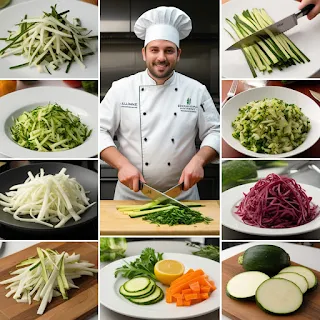Mastering Vegetable Cutting Techniques
Proper vegetable cutting techniques are fundamental to creating visually appealing and evenly cooked dishes. How you cut vegetables directly impacts the cooking time, texture, and flavor of your dish. Whether you're a professional chef or a home cook, understanding the main types of vegetable cuts will enhance your culinary skills and the overall quality of your meals. This guide explores the 8 main types of vegetable cutting techniques, their applications, and additional tips to elevate your kitchen practice.
Why Vegetable Cutting Matters
The way vegetables are cut affects:
- Cooking Time: Smaller, uniform pieces cook faster and evenly.
- Texture: Different cuts create varying textures, adding interest to your dishes.
- Flavor: Uniform cuts ensure even seasoning and balance in flavor.
- Presentation: Well-cut vegetables elevate the aesthetic appeal of any dish.
1. Julienne (Matchstick Cut)
- Description: Thin, uniform strips resembling matchsticks.
- Size: 3 mm x 3 mm x 5 cm.
- Uses: Stir-fries, salads, garnishes.
- Vegetables: Carrots, cucumbers, peppers, zucchini.
2. Chiffonade (Ribbon Cut)
- Description: Fine ribbons created by stacking and rolling leafy greens or herbs, then slicing.
- Size: 4–10 mm wide.
- Uses: Garnishes, sautés, stuffing.
- Vegetables & Herbs: Spinach, basil, mint, sorrel.
3. Brunoise (Fine Dice)
- Description: Small, uniform cubes derived from julienned vegetables.
- Size: 1–3 mm cubes.
- Uses: Garnishes, sauces, stuffing.
- Vegetables: Root vegetables, onions, celery, peppers.
4. Dice (General)
- Description: Uniform cubes in varying sizes based on the dish's requirements.
- Categories:
- Macédoine (Small Dice): ¼-inch cubes.
- Medium Dice: ½-inch cubes.
- Carré (Large Dice): ¾-inch cubes.
- Uses: Soups, salads, stews.
- Vegetables: Carrots, potatoes, squash.
5. Batonnet (Stick Cut)
- Description: Larger sticks, slightly thicker than Julienne.
- Size: 5 mm x 5 mm x 5 cm.
- Uses: French fries, vegetable sticks, appetizers.
- Vegetables: Carrots, celery, zucchini.
6. Chop
- Description: Non-uniform, rough cuts, often larger in size.
- Uses: Soups, stews, and rustic dishes.
- Vegetables: Onions, carrots, celery.
7. Paysanne (Flat, Rustic Cut)
- Description: Thin, flat shapes mimicking the vegetable’s natural form.
- Size: Approximately 1–2 mm thick.
- Uses: Stews, sautés, soups.
- Vegetables: Potatoes, carrots, zucchini.
8. Ground Meat (Fine Grind)
- Description: Extremely fine chopping or grinding of meat or vegetables.
- Uses: Burgers, meatballs, fillings.
- Ingredients: Onions, garlic, meats.
9. Slice
- Description: Thin, broad pieces cut across the vegetable's length or width.
- Uses: Salads, casseroles, snacks.
- Vegetables: Cucumbers, onions, eggplants, tomatoes.
10. Macédoine
- Description: Uniform small dice for vegetables or fruits.
- Size: ¼-inch cubes.
- Uses: Salsas, soups, salads.
- Vegetables: Mixed vegetables, fruits.
11. Mirepoix
- Description: Roughly chopped vegetables used as a flavor base.
- Size: 1–2 cm pieces.
- Uses: Stocks, stews, sauces.
- Vegetables: Onions, carrots, celery.
12. Rondelle (Round Cut)
- Description: Circular slices cut from cylindrical vegetables.
- Uses: Garnishes, stir-fries, salads.
- Vegetables: Carrots, cucumbers, zucchini.
13. Émincer (Thin Slices)
- Description: Very thin slices for delicate presentation.
- Uses: Garnishes, salads.
- Vegetables: Onions, leeks, garlic.
14. Bias Cut
- Description: Diagonal slices to increase the surface area.
- Uses: Stir-fries, sautés.
- Vegetables: Carrots, green beans, asparagus.
15. Chateau (Barrel Cut)
- Description: Seven-sided barrel-shaped vegetables.
- Size: Approximately 2 inches long.
- Uses: Roasting, boiling, baking.
- Vegetables: Potatoes, carrots, squash.
16. Concasse
- Description: Peeled, seeded, and roughly chopped tomatoes.
- Uses: Sauces, salsas.
- Vegetables: Tomatoes.
17. Julienne/Batonnet/Pont Neuf (Strip Cuts)
- Description: A combination of matchstick (Julienne), thin (Batonnet), and thicker cuts (Pont Neuf).
- Uses: French fries, vegetable garnishes.
- Vegetables: Potatoes, zucchini.
18. Oblique (Roll Cut)
- Description: Irregular, angled cuts achieved by rotating the vegetable after each slice.
- Uses: Stews, rustic dishes.
- Vegetables: Carrots, parsnips, zucchini.
19. Tournée
- Description: A football-shaped cut with seven equal sides.
- Size: Approximately 2 inches long.
- Uses: Elegant plating, soups, stews.
- Vegetables: Potatoes, carrots, squash.
20. Mincing
- Description: Extremely fine chopping of vegetables or herbs.
- Uses: Garnishes, stuffing, blending into sauces.
- Ingredients: Garlic, onions, parsley, ginger.
21. Chiseled Cut
- Description: Angular decorative cuts used for presentation.
- Uses: Garnishes, upscale dishes.
- Vegetables: Cucumbers, carrots, radishes.
22. Jardinière
- Description: Larger, rectangular sticks.
- Size: Approximately 4 mm x 4 mm x 2.5 cm.
- Uses: Stews, soups.
- Vegetables: Carrots, celery, zucchini.
Tips for Successful Vegetable Cutting
- Use a Sharp Knife: A sharp knife ensures clean cuts and reduces the risk of accidents.
- Stable Cutting Surface: Always use a stable wooden or plastic cutting board.
- Uniformity Matters: Consistent sizes ensure even cooking and professional presentation.
- Practice Makes Perfect: Regular practice will enhance your confidence and precision.
- Safety First: Tuck your fingers under and use the "claw" grip for better control.

